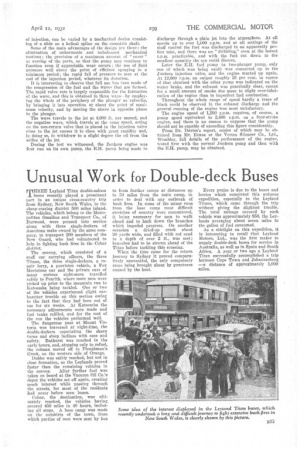Unusual Work for Double-deck Buses
Page 53

If you've noticed an error in this article please click here to report it so we can fix it.
MHREE Leyland Titan double-saloon buses recently played a prominent part in an unique cross-country trip from Sydney, New South Wales, to the sheep-rearing district 500 miles inland. The vehicles, which belong to the Metropolitan Omnibus and Transport Co., of Burwood, were pressed into service along with three single-deckers of American make owned by the same company, to transport 200 members of the New Guard, who had volunteered to help in fighting bush fires in the Caber district.
The convoy, which consisted of a staff car carrying officers, the three Titans, the three single-deckers, a repair lorry, a provision vehicle, a Fox Movietone car and the private cars of many curious sight-seers travelled safely to Penrith, where more men were picked Up prior to the mountain run to Katoomba being tackled. One or two of the vehicles experienced slight carburetter trouble on this section owing to the fact that they had been out of use for six weeks. At Katoomba the necessary adjustments were made and fuel tanks refilled, and for the rest of the run the vehicles performed well.
The dangerous pass at Mount Victoria was traversed at night-time, the double-deckers negotiating the sharp turns and steep inclines with ease and safety. Bathurst was reached in the early hours, and, stopping only to refuel, the column moved off to Ploughman's Creek, on the western side of Orange.
Dubbo was safely reached, but not in close formation, as the Leylands proved faster than the remaining vehicles in the convoy. After further fuel was taken on board at the Vacuum Oil Co.'s depot the vehicles set off again, creating much interest while passing through the streets, for most of the residents had never before seen buses.
Cobar, the destination, was ultimately reached, the vehicles having covered 450 miles in 40 hours, including all stops. A base camp was made on the outskirts of the town, from which parties of men were sent by bus
to form further camps at distances up to 50 miles from the main camp, in order to deal with any outbreak of hush fires. In some of the minor runs from the base camp most difficult stretches of country were encountered, it being necessary for men to walk ahead and to hack down the branches which impeded progress. On another occasion a dried-up creek about 20 yards wide, and filled with red sand to a depth of over 2 ft., was met ; branches had to be strewn ahead of the Titan before tackling this crossing.
When the time came for the return journey to Sydney it proved comparatively uneventful, the only compulsory stops being brought about by punctures caused by the heat. Every praise is due to the buses and lorries which completed this arduous expedition, especially to the Leyland Titans, which came through the trip without giving the slightest trouble. The total mileage covered by each vehicle was approximately 950, the Leylands averaging about seven miles to the gallon of fuel consumed.
As a sidelight on this expedition, it is interesting to recall that Leyland Motors, Ltd., was the first maker to supply double-deck buses for service in Australia, as well as in Spain and South Africa. A year or two ago a Leyland Titan successfully accomplished a trip between Cape Town and Johannesburg —a distance of approximately 1,000 miles.




































































































